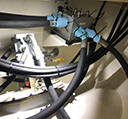
Tips for repair of Hydraulic Cylinder Repair
In this modern-day world, with all the current innovations in equipment, using Hydraulic cylinders plays a significant function in a large range of applications. This system is a basic plan of piston and cylinders that can raise heavy items. Most of the car parts or heavy equipment functions on the concept of hydraulics. There are a couple of other systems like excavators, elevators, bulldozers, and forklifts that use hydraulic cylinders too.
These systems are available in differing sizes, for example when setting up in vehicles, they are available in small sizes, whereas, in much heavier applications like heavy bulldozers or dumpster trucks they are available in bigger sizes for smoother maneuvering and simple lifting. All cylinders share the typical parts, repair and maintenance treatments.

Before we continue with the hydraulic hose repair treatments, let us find out the general causes that result in cylinder malfunctioning.
Reasons for Failure of Hydraulic Cylinder System.
A bent piston rod can overload the hydraulic system.
Due to constant long use, there can be a fracture in the system.
Due to relentless wear and tear, the seal of the hydraulic cylinder may split or break.
There are possibilities of the piston rings to get harmed.
Whenever you delight in some cylinder repair, keep your repair tool package all set for use. Usually, a toolset includes lubrication, new shaft seals with O-shaped rings and a new cylinder rod.
How to Repair a Hydraulic Cylinder.
Action 1.
Dis-assembly: Remove the cylinder from the machine. Open the cover of the cylinder utilizing the bolts or screws and remove the piston out of the cylinder. Now loosen up the input valves to decrease the pressure and move the piston shaft in outside instructions to separate it entirely.
Action 2.
Assessment: This is an important phase of hydraulic cylinder reconstruct, where, you have to carry out a visual evaluation to find out the primary issue. If the cylinder bore is scratched or the piston shafts are bent, the system needs a certified hydraulic service center. In case, if the shafts or bolts are undamaged, probably the seals are burst causing excess hydraulic fluid leakage.
Action 3.
Re-pack the Seals: Utilizing the seal set and the repacking guidelines for your cylinder thoroughly remove the old seals from its positions and repair the news ones in place of the old ones.
In this last of repair, oil the seals with the oil and carefully move the piston back into the cylinder system. Make sure the input valves are loosened up for the piston to move inefficiently. Before connecting the cylinder once again to your devices, ensure you examine for any leak and the condition of the hydraulic tubes.
Preserving Operating Conditions.
The supreme life span of the hydraulic hose pipe grossly depends upon the operating conditions. To put it simply, the working conditions of the pipe really identify its life span. Every pipe’s rubber tube and cover are delicate to the extremes of temperature, too expensive temperature at day time or too cold temperature during the night can affect the hose pipe’s age adversely. Severe pressure changes too can prove hazardous for the pipe life span.
